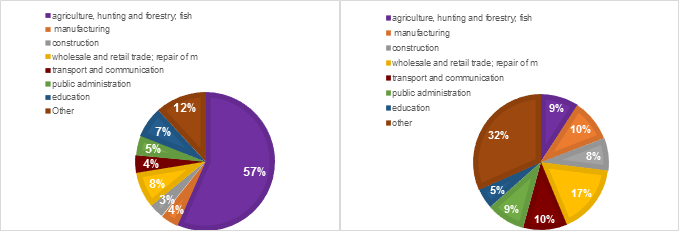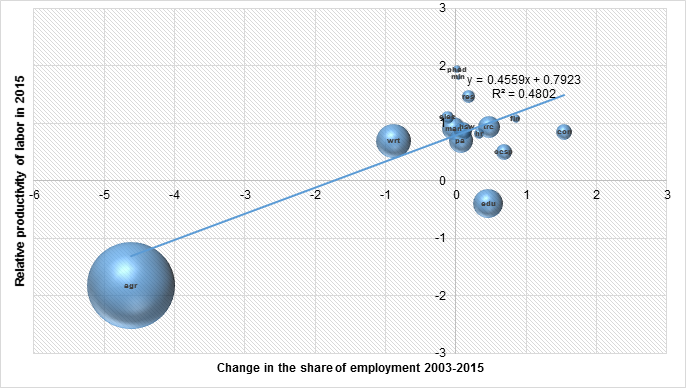 02
July
2024
02
July
2024
ISET Economist Blog
 Monday,
21
November,
2016
Monday,
21
November,
2016

 Monday,
21
November,
2016
Monday,
21
November,
2016
Structural transformation of the economy is one of the most important determinants of economic development. Almost invariably, nations that have managed to pull themselves out of poverty were able to diversify their economies away from low productivity sectors. In advanced countries, productivity differences between sectors are generally small, and growth mostly happens because of productivity improvements within sectors. Developing countries, on the other hand, are characterized by large productivity gaps between the sectors of their economies. These gaps are potentially good growth engines. When a labor force moves from a low productivity sector to a high productivity one, economic growth happens even if there is no productivity improvement within the sectors. This “development recipe” sounds simple, yet the speed of structural transformation differs greatly between countries. One may say that this is the key factor that differentiates unsuccessful economies from successful ones.
Globalization and regional integration have affected developing countries (including transition economies), almost without exception, by making them more and more integrated into the world economy. Industrial tariffs are historically low, foreign direct investment flows are high, and transfers of technology are becoming easier than ever before. However, the outcomes of embracing globalization depend largely on the manner in which countries integrate into the world economy. As Dani Rodrik and Margaret McMillan argue in “Globalization, Structural Change and Productivity Growth” (2011), globalization in emerging Asia initiated the right path of structural change and contributed to fast economic growth. But in the case of Latin America, labor has moved in the wrong direction, from highly productive to less productive sectors, including the informal sector.
It is a widely recognized fact that the Soviet Union was an over-industrialized economy, with an exceptionally high labor concentration in the industrial sector, as compared to the other middle-income countries in the world. Mickiewicz and Zalewska in their article “Deindustrialization. Lessons from the Structural Outcomes of Post-Communist Transition” (2002) analyze the main reasons for the over-industrialization of the USSR. The authors claim that the relatively high concentration of the labor force in the industrial sector was not driven by comparative advantage in industrial exports – after all, USSR was a semi-autarchic country with a small share of exports in GDP – or rich resource endowments – natural resources were not uniform across the republics, while the pattern of over-industrialization was common to all. Rather, this phenomenon was a consequence of military aspirations and considerations based on ideology. Therefore, after the Soviet Union collapsed, one should have expected an intensive deindustrialization process, which indeed was what happened.
Across the former USSR, the transition to a market economy and increased integration with the world market resulted in an immediate reduction of labor employment in the industrial sector and created the need for ambitious reforms. Successful transition economies (like the Baltic countries) managed to implement these reforms in a way that led to structural transformation in the “right” direction, i.e, labor moved from the industrial sector to high-productivity services.
Georgia, unfortunately, was the most distinctive case of ineffective structural transformation following the collapse of the USSR. In the early stages of transition, Georgia experienced several wars and cascades of unsuccessful reforms which resulted in destroyed infrastructure, problems with tax collection, hyperinflation, high corruption, and increased criminal activities. This, of course, killed the incentives to invest and do business in Georgia. As a result, excess labor from the deindustrialization process moved into subsistence agriculture. In 1990, the share of agricultural employment in Georgia’s total employment was 26.3%, while the corresponding values in industry and services were 31.2% and 14.6%, respectively. By 2000, however, the share of employment in agriculture dramatically increased to 52.1%, the share of employment in services increased only slightly to 17.8%, and industrial employment was only 9.8% of total employment (Raiser, Schaffer and Schuchhardt, 2003). Therefore, it is clear that Georgia experienced a “growth reducing” structural transformation, as labor moved from more productive sectors to less productive ones.
Despite the fact that Georgia experienced a series of successful reforms after the Rose Revolution (2003), the structure of employment did not change that much. The first chart below shows the share of employment in different sectors of the economy in 2015. The agricultural sector was still the leader in terms of labor employment, absorbing 57% of the employed population. On the other hand, the importance of manufacturing in terms of labor employment is extremely low, with only a 4% share. Furthermore, it is notable that 5% of employed people are still involved in public administration (which is ranked fourth in terms of employment shares). This employment structure is sharply different from what we commonly observe in successful transition countries, which are characterized by a high share of employment in high productivity services, and a low share of employment in agriculture.
The second chart below provides information about different sectors in Gross Domestic Product. Here we can see quite clearly that the most unproductive sector in Georgia is, of course, agriculture, where 57% of employed people contribute only 9% to the GDP.

In the right direction at a turtle’s pace.
So, where do we go from here? How can we assess whether the post-Rose Revolution Georgia has been moving in the right direction as far as the structural transformation of the economy? McMillan and Rodrik (2011) give us an interesting tool for assessing the direction of structural change. According to the authors, structural changes are growth-reducing if the labor force moves over time to low productivity economic sectors (in this case, the increase in the flow of labor into the sector will be correlated with the reduction of relative labor productivity in that sector).
The change in employment in a particular sector is determined by the change in the share of employed people in this sector, relative to total employment between 2003 and 2015. Relative productivity is computed as the ratio of the productivity of a corresponding sector to the total productivity of the economy in 20151.
The scatter plot below2 provides several interesting insights into the structural changes in Georgia between 2003 and 2015. We can see a positive and significant correlation between the change in the share of employment and relative productivity of labor, which indicates a growth-enhancing structural change. The main driver of this pattern is the reduced employment in the unproductive agricultural and relatively less productive wholesale, retail trade, and repair of motor vehicles sectors. The number of workers in the agricultural sector declined steadily, starting from 60.56% (2011) to 56.63% (2015) of total employment. In addition, employment increased in the relatively high productivity sectors, like construction and financial services. This contributed to structural transformation-led economic growth and explains the positive slope of the regression line. The only sector with lower than average productivity that experienced an increase in employment between 2003 and 2015 was education, where the share of the employment increased by 0.46%.

From the scatterplot, it is clear that the majority of the economic sectors are concentrated along the Y-axis, which represents no change in employment. This finding is not surprising for some relatively productive sectors, like mining and quarrying, and the distribution of electricity. These sectors are not labor-intensive, and therefore, the increased production is not due to hiring more labor. These sectors were simply not able to absorb the working population from lower productivity sectors, like agriculture. The more worrying cause is the lack of change in the share of employment in manufacturing. The size of this sector in Georgia is significantly behind the benchmark values of successful transition countries.
Despite the fact that Georgia has been experiencing a growth-enhancing structural transformation, with changes moving in the right direction, the speed of structural changes has been notably low. The fastest change was observed in the agricultural sector, where the share of employment dropped by 4.62%. This is not fast enough, as Georgia is still very far away from the structural decomposition of successful nations. To catch up with developed countries, Georgia should speed up structural transformation by diversifying industrial exports (moving away from raw materials export); creating a comparative advantage in tradable sectors, such as manufacturing; creating macroeconomic conditions to keep exports competitive; improving labor skills to enhance labor mobility; and last but not least, creating and maintaining a good environment for business investment.
1 The relative productivity of a sector is determined by the nominal GDP per employed worker in this sector. If the correlation between change in employment and the natural logarithm of the relative productivity of the labor is positive, the country experiences growth-enhancing structural change. The relative size of each sector in 2003 is indicated by the size of the circles presented in the scatter plot. The speed of structural changes is determined by the magnitude of the change in employment. The higher the share of people moving to the other sector, the more rapid is the structural transformation.
2 Correlation between sectoral productivity and changes in employment share in Georgia, 2003-2015 Source: Geostat – Integrated Household Survey (IHS) Abbreviates: agr –agriculture, hunting and forestry; fishing, wrt – wholesale and retail trade; repair of vehicles, elec – production and distribution of electricity, man – manufacturing, hsw – health and social work, pa – public administration, phed – private households employing domestic services, min – mining and quarrying, res - real estate, renting and business activities, hr –hotels and restaurants, trc – transport and communication, ocsp – other community, social and personal services, fin – financial intermediation, con – construction, edu – education.





